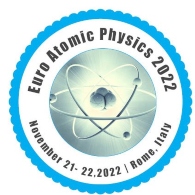Call for Abstract
Scientific Program
World Congress on Atomic Physics and Nuclear Physics, will be organized around the theme “Theme:Moving to Master Physics at Atomic Level”
Euro Atomic Physics 2022 is comprised of keynote and speakers sessions on latest cutting edge research designed to offer comprehensive global discussions that address current issues in Euro Atomic Physics 2022
Submit your abstract to any of the mentioned tracks.
Register now for the conference by choosing an appropriate package suitable to you.
Atomic physics studies about the atoms which isolates the system of electrons and an atomic nucleus. This deals with the properties of atoms, which are mostly due to their electron configuration. Atomic physics is mainly concerned with electrons encircling the nucleus of an atom. It has led to important applications in medicine, lasers, communications, etc. and also providing a testing ground for Quantum Theory, Quantum Electrodynamics and its derivatives.
Nuclear physics is the field of science that studies about atomic nuclei, constituents and interactions. Nuclear Physics on the other hand, apprehensions itself with the particles of the nucleus called nucleons (protons & neutrons). The research in this field has led to many applications such as nuclear power, nuclear weapons, nuclear medicine, nuclear magnetic resonance imaging. The modern nuclear physics includes nuclear fusion, nuclear fission, nuclear decay and Production of "heavy" elements using atomic number greater than five.
Quantum physics also known as quantum mechanics which includes the quantum field theory is a division of physics which describes the nature at the minimum scales of energy levels of subatomic particles and atoms. Quantum physics can release the separate performances of the subatomic particles that consists all forms of matter (electrons, protons, neutrons, photons, and others). Heavy nucleus which contains hundreds of nucleons is treated as a quantum-mechanical one.
Quantum mechanics (QM; also known as quantum physics, quantum theory, the wave mechanical model, or matrix mechanics), including quantum field theory, is a fundamental theory in physics which describes nature at the smallest scales of energy levels of atoms and subatomic particles. The applications of Quantum Mechanics include Electronics, Cryptography, Quantum Computing, Macroscale Quantum Effects, Quantum Theory.
Atomic spectroscopy studies about the electromagnetic radiation absorbed and emitted by atoms. In the determination of elemental compositions the electromagnetic spectrum or mass spectrum is applied that can be distributed by the type of spectroscopy used or with the atomization source. For systematic use the technology of atomic spectroscopy has generated three techniques such as Atomic Absorption, Atomic Emission and Atomic Fluorescence. The transitions involve the relaxation and excitation of the outer or bonding shell electrons of metal ions and atoms and the corresponding photons have energies inside the visible regions of the spectrum and ultraviolet. A decent instance of this is the dark absorption lines in the solar spectrum.
Atomic Astrophysics implements atomic physics calculations which use atomic data for reading astronomical observations. Atomic physics plays a main role in the arena of astrophysics because the astronomers get the information about any particular object through the emitted light, as this light will arise through the atomic transitions. Molecular Astrophysics studies about the emission of molecules which are in space. The molecules which are having more number of observable transitions are nearly 110 interstellar molecules.
Laser stands for Light Amplification by Stimulated Emission of Radiation. The physics of an atom laser is similar to that of an optical laser and the main difference between an optical and an atom laser is that atoms interact with themselves, cannot be created as photons and retain mass whereas photons do not. Main applications of the atom laser are atom holography and atom interferometry.
Plasma physics is the study of a state of matter comprising charged particles. Plasmas are usually created by heating a gas until the electrons become detached from their parent atom or molecule. This so-called ionization can also be achieved using high-power laser light or microwaves. Plasmas are found naturally in stars and in space.
Lightning is an example of plasma present at Earth's surface. Typically, lightning discharges 30,000 amperes at up to 100 million volts, and emits light, radio waves, X-rays and even gamma rays. Plasma temperatures in lightning can approach 28,000 K (28,000 °C; 50,000 °F) and electron densities may exceed 1024 m−3.
Nanotechnology is the study and application of very small things which is about 1 to 100 nanometers. Nanotechnology is control of matter on a nuclear, sub-atomic and supramolecular scale. Nanotechnology as characterized by size is actually extremely wide, including fields of science as different as surface science, natural science, sub-atomic science, semiconductor material science, micro fabrication, sub-atomic building and so on.
Nuclear reactor physics deals with the study and application of chain reaction to make a controlled rate of fission in a nuclear reactor for the production of energy. Many nuclear reactors use this chain reaction to bring a controlled rate of nuclear fission in fissile material which releases both energy and free neutrons. The reactor comprises of nuclear fuel, generally surrounded by a neutron moderator such as regular water, heavy water, graphite or zirconium hydride.

